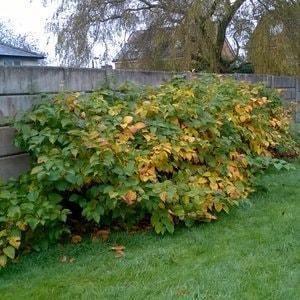WHAT’S THE REAL-life IMPACT OF KNOTWEED?
This is a topic that must be a concern for a lot of homeowners, property management agents and local authorities. Stepping aside from the most popular answer “knotweed causes damage to structures and property” let’s look at the other impacts knotweed growth has on the use of amenity spaces.
what is an amenity space?
An amenity space can be defined as either residential (privately owned) exterior spaces or public open spaces.
RESIDENTIAL
Residential amenity space is typically privately owned gardens or homeowner’s outside property space. In 2022 the Royal Institute of Chartered Surveyors (RICS) updated guidance “Japanese Knotweed and Residential Property” for assessing the risk to residential property posed by Japanese knotweed. It specified 4 management categories (A-D) with A being the most severe and B relating to when knotweed impacts on the free amenity use of the property.
Management Category B: The knotweed is on-site, not causing material damage to a structure but likely to prevent the use of or restrict access to amenity space. Lending advice = No Mortgage until a specialist report is obtained and a suitable remedial plan is agreed. Non-Lending advice = Specialist Remediation Contractor to advise appropriate action.
PUBLIC
Public amenity spaces are publicly used areas that are not privately owned. This includes areas of land or gardens managed by property management agents or companies. Green amenity spaces, or public open spaces that are incorporated into residential sites to enhance the landscape where people live, such as parks and play areas. Highways amenity areas such as footpaths and roads owned by local authorities and some sports grounds and associated amenities such as car parking areas. Open amenity spaces are often environmental habitats left undeveloped in order to encourage native wildlife and maintain the local ecosystem.
Amenity spaces have many benefits:
- Studies have shown that over 70% of homeowners and residents deem gardens or use of open amenity spaces as essential for general wellbeing.
- Amenity spaces reduce stress levels and provide a place for open air activities.
- Open or green spaces, or shared gardens are especially important for block residents or homeowners without a garden.
- Parks and play areas encourages social interaction and child development.
- More green areas means more native flora and fauna.
The real issues for amenity spaces
Japanese knotweed growth impeding access through public open space.

Japanese knotweed growth impeding use of residential amenity space and usage.
If left to grow uncontrollably knotweed forms large dense bushes (or stands). The size and nature of this plant in mature form severely impedes maintenance, access routes for humans and a natural ecological environment for wildlife and native plants. But lets look in more detail at some of the real amenity space impacts of knotweed to different industry sectors:
- Impact is caused by the presence of the dense tall growth of knotweed and difficulties in maintaining/removing it as a legislated plant.
- Impact is also cause by the plants extensive underground rhizome area, preventing free ability to disturb surrounding ground without the risk of spreading the plant further.
- Loss of private amenity space is the 2nd highest management category under the RICS guidance affecting residential properties.
- For homeowners and residents knotweed can limit or significantly impede the ability to freely use or maintain their property.
- For property management agents knotweed outbreaks will be a problem with fulfilling contractual grounds maintenance activities, it also puts additional burden on their yearly budget.
- For local authorities, knotweed can quickly cause problems if there is no duty of care to its maintenance, risking conflicts with neighbouring properties and causing a private nuisance in allowing knotweed to spread.
- Public amenities such as parks, public footpaths and parking areas can become overgrown with knotweed, reducing access, space, use and associated revenue.
- Knotweed on adopted roads create issues for facilities management such as refuse collection.
On an environmental note, knotweed will out-compete native plants very quickly, it’s dense coverage forms a light blocking canopy that kills plants beneath, however this can also impact amenity spaces by altering the natural habitat and it’s appearance. People do not want to see their green spaces once visually attractive with a variety of plants, flowers and trees, now smothered with knotweed.
How is knotweed controlled in amenity spaces?
On residential properties if knotweed is impacting on amenity space it may also impact the value of the property and ease of obtaining lending. A mortgage lender will likely require a management plan to be in place to provide herbicide treatment accompanied by an insurance backed guarantee. The alternative measure is excavation, which can be looked upon favourably in instantly removing the problem and the related amenity impact issues.
For Local authorities and Facilities Maintenance, Japanese knotweed is just one of many invasive and amenity weeds that need to be effectively controlled either on a yearly basis with planned treatments or completely eradicated via excavation. Herbicide control is cost effective and controls the spread of knotweed and long term can result in controlled dormancy. In carrying out herbicide control work within amenity spaces we have clear health and safety guidelines that all field based staff must follow. Where long-term herbicide control is undesirable, or if the area is proposed for change of land use (i.e. re-landscaping or development) then Japanese knotweed will require excavation. Excavation is an instant and permanent fix with arising wastes either removed to landfill or sustainably disposed of on-site via relocation or burial. All methods of control must abide by duty of care regulations and legalisation.
Conclusion
It’s clear that Japanese knotweed has a social, environmental, and economic impact on amenity spaces, and only carefully managed methods of control will be effective long-term. Getting that programme right ensures access to and use of amenity areas remains problem free. We also control general and injurious weeds in Amenity Space for Local Authorities and other commercial enterprises through our Amenity Weed Management service. For weed control on commercial and public amenity space please visit our sister brand Environment Controls.
If you’d like to speak to us about Japanese knotweed and other invasive weeds control or removal in amenity spaces, please use the contact form below.



